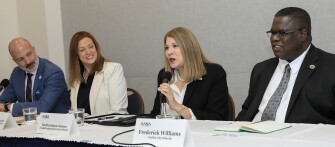Editor’s note: Education Week Staff Writer Caitlynn Peetz served as moderator of the panel discussion among the four finalists for AASA’s National Superintendent of the Year award held Jan. 11 at the National Press Club in Washington.
School district leaders learned valuable lessons in addressing students’ needs with innovation and efficiency in recent years with the help of billions of dollars in federal pandemic relief funds, according to the four 2024 finalists for National Superintendent of the Year.
It was clear from the start that the extra money was time-limited, so it was important that districts find a way to craft sustainable initiatives, the superintendents said during a Jan. 11 panel discussion hosted by AASA, The School Superintendents Association, which runs the National Superintendent of the Year program.
Their comments highlighted what is expected to be one of the biggest challenges in K-12 education this year: how districts across the country can confront the Sept. 30 expiration of the additional dollars that have funded important work to catch students up academically and support their well-being after the interruptions caused by the pandemic.
Nationwide, in the first year of the pandemic, Congress sent public schools $190 billion to help them bounce back from pandemic closures and accelerate student learning. That’s more than three times what public schools receive from the federal government in a normal year.
In St. Paul, Minn., Joe Gothard said he “called to double check that number was accurate” when he learned his district was slated to receive more than $206 million.
It was a shock, he said, but a pleasant surprise that funded the creation of a districtwide “innovation office.”
Staff in that new department conducted a “needs assessment” that produced several ideas for new and needed initiatives, like overhauling the 33,000-student district’s reading instruction strategy so literacy lessons were based on the available evidence about how students learn best to read.
Part of the new initiative included community outreach that was candid with parents, telling them “there’s a new way to do this that we haven’t been doing so well,” and teaching parents how they can support students’ literacy at home. He expects the work to continue long after pandemic relief funds expire.
“I did not want to take that money and spend it in the way that we’ve always spent our money,” Gothard said. “… We had to do more.”
Martha Salazar-Zamora, the superintendent in Tomball, Texas, said she and her staff invested in sustainable revenue projects, like purchasing a 70-acre property that was in foreclosure. Tomball paid $37 million for the property, which is valued at more than $400 million, she said. The 20,000-student district now uses part of the land and some of the existing buildings on the property to house its career and technical education program. The district leases the other part to earn income, she said.
“When you think about the programs we put in place, we had to find a way to generate dollars that weren’t going to be coming in later,” Salazar-Zamora said. “As superintendents, when the dollars end, we have to continue to find ways in our community … in which we can generate dollars. The students need those dollars and we need to be creative in a way in which we perhaps have never had to be in the past.”

Frederick Williams, the superintendent in Dublin, Ga., said his district used pandemic relief money to combat two “pandemics” that plagued his district prior to COVID-19: a large budget deficit and a high school graduation rate that hovered around 70 percent.
Most notably, he said, the 2,300-student district used relief funds to “step across the pre-K fence” to start an early childhood learning academy in an attempt to fight the academic disadvantages that families in poverty face, like a greater likelihood that their children won’t read at grade level and will be chronically absent.
He also prioritized mental health counselors, hiring one for each of the district’s six campuses, and more than doubled the district’s nursing staff. He said those staffing additions would be retained through grants and other supplemental funding district leaders have “aggressively pursued” in recent months.
“With over 63 percent of your kids in poverty and 100 percent of your students receiving free lunch and free breakfast, it really calls on you to not even think outside the box but build a new box … to be able to meet every child’s needs,” Williams said.
Moving forward, to avoid major budget deficits that affect students’ academic experiences, states may need to consider overhauling how they fund education, said Kimberly Rizzo Saunders, superintendent of the Contoocook Valley School District in Peterborough, N.H.
That’s especially true in states like New Hampshire that provide little funding, leaving districts to rely on contributions from local taxpayers, she said.
A New Hampshire judge late last year ruled that key facets of the Granite State’s system for funding its public schools are unconstitutional. The judge determined the state’s base aid to school districts was far too low and that a state policy allowing wealthy towns to retain excess money they collect from local property taxes specifically for schools—rather than redistributing it to poorer towns—ran afoul of the state’s constitution.
The 2,000-student Contoocook Valley district was among the New Hampshire districts behind the lawsuit that resulted in the judge’s finding that the state’s “base adequacy” rate—the minimum amount it provides each year to all school districts—should rise from the current $4,100 per student to at least $7,356.01
“If you’re a property-poor community, then you really struggle to provide your students with the resources necessary for high-quality public education,” Rizzo Saunders said. “What we need in our state is for them to really look hard at how they decide the adequacy formula, what they are actually giving to communities … and then how they can target funds to places and students that need funds in a deeper and more meaningful way.”

